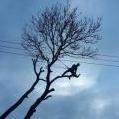Reg, few quick thoughts on the issue.................
most of your work involves long ascents and descents which SRT is brilliant for. A lot your work is spiked removals and other than the re-direct limitations of DdRT when compared to SRT I can't see a major advantage in that scenario.
SRT is good but there's no way it will replace DdRT wholesale - for most climbers DdRT when not rushed and carried out by an experienced climber is far smoother than SRT, it's 2:1, it's less bouncy, it's better for fine adjustments when getting into a work position, the system tightens easier (easier than a ropewrench set up anyway). Psychologically and visually DdRT will always feel safer than a single line, ok DdRT is still a single line, but it's a doubled single line and for most people that will look twice as safe as a single line especially on a long branchwalk at 70ft.
The SRT base tie off for working in a tree is an inherently bad idea, top tie fine. With DdRT every part of the working line is above you and in most situations it's visible, in contrast large portions of a base tie SRT down line are not seen, that's always gonna be a concern........... the ground rescue argument of a base tie off is bordering on pathetic because you're essentially arguing it's safer to climb on a more dangerous system (base tie) because you can be rescued from the ground. I'm not saying you expect to be rescued from a base tie but many people advocating SRT use base tie offs with belay devices whilst working in the tree.
SRT is much quicker and more efficent for ascent into big/tall trees no denying that (provided the climber can set a line with a bag within a few attempts).
You say you get more work done in a day with SRT, fine now that you're working for yourself, would you say the same if still contract climbing?
.


.jpg.e78d23f57b029caf0a7282c8ab545f75.jpg)




